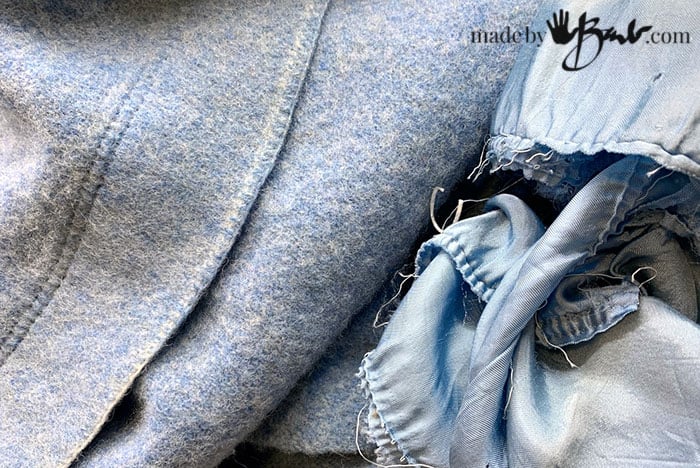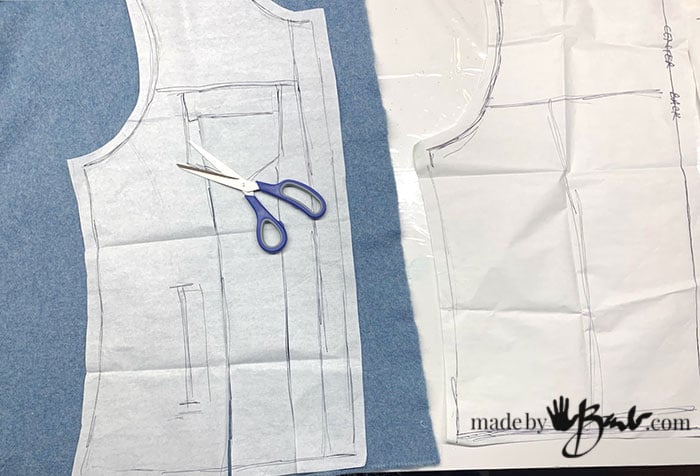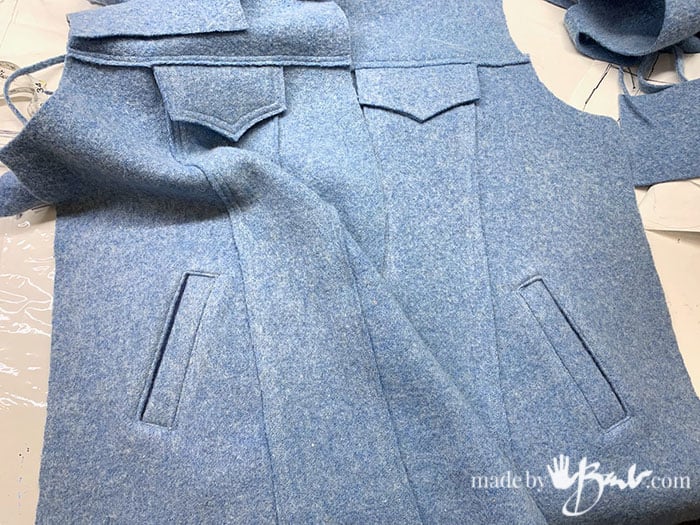Make a Jacket from a Wool Blanket

The more you make things with fabric, the more you appreciate certain fibres! Virgin wool blankets (felted) are a treasure and can be used so many ways! My fall project; Make a Jacket from a wool blanket.

Why Use Wool?
Look at those adorable faces! They gift us their ‘coat off their back’ so why not continue to use it for all the great properties of Wool?! There are many reasons that the old fisherman had their thick wool sweaters. I had no idea how strong it is; each fibre can bend back on itself over 20,000 times. It has the ability to absorb moisture to up to 30% of its’ own weight but resists building up bacteria since it releases it back into the air. The crimped nature of the fibres makes it able to return to its’ shape after wearing. It is biodegradable and each sheep makes a new fleece each year.

Virgin wool, what does that mean? It means it’s either from the Lamb, first shearing of the sheep or that it has not been recycled. I’ve been sewing for decades and as of late it’s almost impossible to find natural fibre fabrics in a store. These blankets have a lot of yardage when you find them in a thrift store so they are well worth the few dollars. I love using them for many projects

These vintage blankets often have a satin binding around the edges. If it seems puckered it’s probably that the blanket was washed and has shrunk a bit making the binding seem too big. It easy to take it off, and it will even eco print if you want. Some ‘Blanket Coat’ designers also reuse it to keep with the theme.

How to Felt A Wool Blanket:
This blanket was already washed but I wanted to ‘felt’ it even more. Felting happens when the scales on the wool ‘hairs’ start to get caught with each other. The heat of the water helps open the scales and the agitation of the process (either by hand or machine) gets them to tangle; to keep the edges from unravelling when cut. I felted mine in my washing machine (it may create a lot of lint so some put it in a pillow case etc) set to hot wash and cold rinse. To aid the rubbing of the fibres I added some jeans and towels to the load. I was pretty happy that the fibres now look like a piece of felt rather than woven threads so less work is needed finishing edges! Sometimes this process needs to be repeated.

Where do I get my Patterns?
Ok, I’ll admit I am a bit of a lazy sewist. I remember the days of cutting those tissue paper patterns out and then trying to follow all the instructions… not fun! Nowadays I sew more intuitively; I use a favourite garment and trace it to make pattern pieces – much quicker and less mystery.

I know that it fits and am a bit generous (you can double check with measuring tape) especially at the side seams to adjusting can happen later (can always add a dart as well). I wanted to make a ‘jean jacket’ style of this wool. After tracing the pieces I added some seam allowance, even though the felted wool will only just need overlap at those seams. I like all the ‘lines’ and details that these jackets have (or should I call it a shacket?) I use scissors since the wool is so thick.

Overlap Seams:
Instead of right-sides together I used flat stitch overlap seams; much less bulky. The sewing machine handles it really well with a slight contrast thread colour. Sewing the dense wool is easy & I love top-stitching. The chest pockets are fake as I never use them. The front edges are cut wider so that a simple fold over & topstitch is enough to make the facing inside.

Good Pockets are a must!
The most energy went it these slash pockets, but it was worth it! There are plenty of instructions on the web, the pocket lining was a thinner fabric though. The back yoke and sleeves are assembled the same way.

All coming together:
The sleeves are attached in the usual way (right sides together). Ease the top round of the sleeve to give a nice shoulder. The collar is 2 layers but still raw edge stitched and attached by overlap. When it came to buttons I chose the hammer-in kind like you see on jeans – super fast and simple. These did cost me more than the blanket though. Toggles as buttons or a zipper would also suit the wool.

Another bonus from the felted vintage wool blanket is that the button holes are easy to do, just a rectangle sewn & sliced down the middle. They end up clean and simple. The cuff is simplified from the usual buttoned style to a folded over strip so it wears well. The bottom strip was also a overlap seam and some buttons at the edge. The edges/seam allowances did not need finishing with a zigzag stitch since the felting helps.
When I sew I do no not want to ‘fight’ with the fabric!

It turned out quite nicely even though it is not lined. I do not see an advantage to lining it. It is longer than the usual jean jacket, below the waist, no belt. You can easily make adjustments like having a hood.

I wear another layer underneath (at least a t-shirt) so the wool does not bother my skin. I especially like nice deep pockets. These fashionable coats of up-cycled wool are becoming quite the rage, as this Dutch company Hul Le Kes making jackets from all sorts of wool blankets.

The collar up, add a nice silk scarf and I’m warm on a wintery day. I now know why I’ve been a bit of a hoarder of wool blankets

These have been some of the easiest buttonholes I’ve made…
Great coat! I’d love to see you offer the pattern for sale.
Oh, I wish I had enough hours in the day… I love making patterns but all the variety of sizes makes for a lot of work. There is this site that will create and make a printable custom pattern of your choice. I used it to make my Dress Form
Beautiful job!
Thank you!!!
What a great jacket 💚🙏🏼 love your work!
Thanks! ‘And I love that the wool can be Eco printed as well.